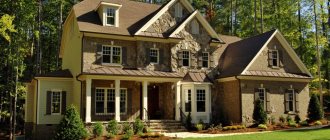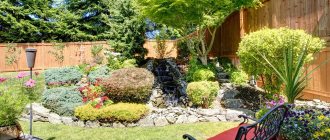Photo: pinterest.ru The opportunity to spend time outdoors is priceless. Especially in the modern rhythm of life. So don’t leave the situation to chance, take the arrangement of your patio into your own hands! A garden gazebo is an ideal find that will save you from the scorching sun or bad weather. You can relax here in silence, then invite your friends for a picnic. A bright and stylish element will decorate the design of the site.
Types of garden gazebos
Gazebos came to us from warm countries: Italy and France. There they protected ladies in luxurious dresses from the sun who went out for a walk in the garden, because snow-white porcelain skin was very highly valued. In our latitudes, gazebos have another important advantage: they protect from wind and sun, and in warm closed structures they can relax even in winter. Especially if you install a grill or stove nearby.
There are two main types: - A pavilion is a closed or semi-closed gazebo with a reliable roof. It has several walls with passages. — An open pergola resembles an arch. It could be just a bench or a swing under a canopy. But pergolas provide worse protection from both the sun and precipitation.
Photo: sad-fialok.ru Photo: trustload.com
Classic gazebos for a private yard
And yet, most homeowners prefer not beautiful or original, but convenient and practical designs. In this regard, wooden buildings in the form of a tower and small forged gazebos are more popular for a private house. A large building under a gable roof can replace a terrace or a summer kitchen, but building a small structure does not make sense, because it will be a waste of money.
As for the design and decor of classic gazebos, a wooden diagonal lattice is used to enclose the side openings. Thanks to this solution, the room remains open, but at the same time shaded from the sun's rays. At the same time, everyone understands that a gazebo is a place of relaxation, where you want to spend time with family and friends and have a delicious meal. Therefore, a barbecue or stove is an indispensable element of a modern gazebo. You can complement the gazebo with a small artificial pond and a path leading to it.
Selecting a location
Most often, gazebos are located right next to the house so that it is convenient to get to them. Or, on the contrary, they hide it in the depths of the garden. This gives it a fabulous, romantic and secluded feel.
In classic, regular gardens, feel free to install the gazebo clearly in the middle. Draw a pair of symmetrical paths to it at the same distance. And build a composition around.
In the eastern gardens, install a gazebo by the pond. Or arrange at least a small symbolic fountain near it. This composition looks very harmonious and holistic.
When placing a gazebo with a barbecue, be sure to take safety precautions into account. They placed it at least 5 meters away from any buildings. Don't forget about the smoke and smell. And ideally, run water to it.
Photo: krov-torg.ru Photo: pxhere.com
Roof options
In the southern regions of the country it is allowed to install flat, horizontal roofs. In regions with frequent rains and snowfalls - sloped. The last type is the most common.
Its main advantage is that for small gazebos there is no need to install slopes, additional poles, or braces for the layered rafter system.
Let's take a closer look at the types of roofs.
Single-pitch
A simple design that does not take a lot of time and materials. It is used in gazebos of square, rectangular, diamond-shaped shapes. The rafter system is layered, attached to 2 opposite walls.
Photo: Asian style design
Gable
The photo shows an example of a gable roof in an open wooden building. The lattice on the walls is made of pine slats coated with varnish.
Optimal type for rectangular structures. The rafter system (hanging, inclined) is selected based on the requirements of the project and the type of roofing material. Easy to make. You can do its installation yourself.
Four-slope
It is issued in two forms:
- 4 triangles connect at one point.
- 2 trapezoids and 2 triangles. Received the name - hip.
It is recommended to build in rooms with right angles. Rafters - layered, hanging.
The latter should be installed in large arbors, strengthened with struts and a central beam.
Photo: installation of a hip roof truss system
Installation of slopes is carried out at an angle from 15 to 45º to the horizontal.
Other types
For round buildings, a hipped (pyramidal) roof is often used, which consists of only triangles. The rafters are slanted.
There are half-hip roofs that are formed from trapezoids and triangles without tops.
In addition, the roof is made insulated, with an insulating layer on the sheathing, or left cold.
Popular materials:
- corrugated sheeting;
- metal tiles;
- polycarbonate;
- slate;
- bitumen shingles;
- ondulin, etc.
Photo: gazebo with thatched roof
The first two are excellent for structures with a stove or fireplace, since they are not flammable.
Wooden gazebos
Wood is the simplest and most versatile material for creating gazebos. It has a lot of advantages:
— A variety of varieties allows you to experiment with styles; — The material is lightweight, so even for a massive structure a lightweight foundation is sufficient; — Natural texture will fit into any garden; — Wood is easy to process, sand and paint; — You can experiment with shapes and configurations; — Wood is the main element of modern eco-styles; — You can make a wooden gazebo yourself or purchase a ready-made one.
The main disadvantage is that this material requires constant maintenance. Especially when it is in the rain and scorching sun.
A classic wooden gazebo can be easily decorated with carved elements. And for lovers of modern styles - all the variety of laconic frame structures with simple geometry.
Another plus is the harmonious combination of a wooden base with tiles and other classic roofing coverings. This is important when creating closed all-season gazebos.
Photo: priozerskdom.ru Photo: premoproducts.com Photo: almode.ru Photo: vashi-lustri.ru Photo: tambov.tiu.ru Photo: go-informator.ru Photo: boydforcongress.com Photo: greenpts.com
Photo: derko.rf Photo: 2gis.ru
Photo: pineshop.ru Photo: mir-besedok.by Photo: svoyabesedka.ru
Various shapes
Gone are the days when the limit to the aesthetic beauty of a gazebo was a hipped roof. Now the shapes can be anything: round, abstract, several floors high. I suggest you study the most interesting examples, some of which you probably have not encountered in real life.
Round
I propose not to consider standard square and rectangular shapes, but to immediately move on to more interesting and complex ones. Round shapes are very common among such structures; you’ve probably encountered them at someone’s dacha.
The shape of the circle does not evoke any admiration for me, although, according to many summer residents, it is very beautiful. The taste and color, as they say...
Polygonal
By the number of slopes you can determine the number of corners in the structure itself. The most popular shapes are quadrangular, hexagonal and octagonal.
The complexity of construction usually depends on the construction of the rafter system. As you understand, a pitched roof is much easier to build than an octagonal one. But these complex buildings look pretty cool. Especially when more expensive material is used for construction.
Comparison with hexagonal gazebo
Wooden hexagonal gazebo idea
Hexagonal shape
Abstract
When you look at the architectural “masterpieces” of dacha residents, you inevitably ask yourself the question; How did you even get the idea to build something like this? Some ideas are extremely impractical and unreliable, but the spirit of adventure is present in them (at least you can grin).
Few are willing to spend their time on gazebos of similar shapes, but modern interior design is moving away from the classics. A design building is considered to be original and interesting.
Stone gazebos
Natural stone is beautiful and luxurious. It is unpretentious, does not require constant maintenance, does not rot and is not afraid of corrosion.
Stone gazebos look great near massive monumental houses. They are strong and durable. And this is the best option for warm winter gazebos or gazebos with barbecues.
The main disadvantage is the high cost of natural stone. It is also heavy and more difficult to work with. But you can save money! First, pay attention to artificial stone and even brick. Secondly, you can use leftover materials after building a house.
Such a gazebo can become a full-fledged capital structure. You can glaze it, install a stove inside, run water. It can even be used as a full-fledged guest house.
Photo: mykaleidoscope.ru Photo: wellstone-russia.com Photo: ss-p.ru Photo: mykaleidoscope.ru
Photo: prostone53.ru Photo: aviaslovar.ru
Photo: pinterest.ru Photo: 2gis.ru Photo: serviceyards.com
Photo: sdelai-lestnicu.ru
Copper sulfate: use of solution in gardening
Purpose and types of foundations
The main task of the foundation is to absorb the loads from the weight of the structure and transfer them to the ground. It is clear that depending on the type of base and how heavy the structure will be, the type is selected:
- slab;
- tape;
- pile;
- columnar.
For heavy structures, a foundation with a larger base area is required - slab or strip, while for light structures a pile or columnar foundation will be sufficient.
But in addition to the load-bearing function, the foundation can perform a number of other tasks:
- protect wall material from ground moisture;
- impart spatial rigidity to the structure;
- exclude the impact of soil on the structure during seasonal freezing;
- level the site for the structure when it is located on uneven terrain.
A gazebo, as a rule, is built from materials that can not collapse due to uneven soil settlement. Since there are often no walls in the gazebo, it has little weight. You can take into account the inclined terrain during construction by leveling the floor using columns. But it is not always possible to say unambiguously whether a foundation is needed for a gazebo
or not. It is also necessary to take into account the operating features of the structure itself.
"Live" gazebos
A beautiful, graceful and elegant gazebo can be created like a hedge. Tall bushes, climbing plants, braided fences - all this will be an excellent solution for a garden gazebo.
Think about the supporting structures that will decorate your plants. For this, it is most convenient to use a metal or wooden frame. Openwork forging or elegant carving will decorate the garden and mark the future gazebo while the plants grow.
Individual “living” fragments can be used when decorating other gazebos. For example, a stone structure entwined with vines, ivy or roses immediately creates the impression of a fairy-tale castle.
Photo: design-homes.ru
Photo: lachat.ru Photo: idei.club
Photo: krov-torg.ru
Photo: hoteldiscount.ru Photo: lkard-lk.ru
Photo: id.gardendecorgalore.com Photo: zgnrus.ru Photo: idachi.ru Photo: serviceyards.com Photo: forfur.com
Sequence of work
Before starting construction, study the design options of this class and their drawings. Careful measurements and a plan are the key to success.
The site is cleared of vegetation and soil is removed to a depth of approximately 20 centimeters. After leveling and reinforcement with metal mesh, the area is ready for concreting.
If the gazebo posts are made of wood, the material must first be treated to protect it from moisture. To do this, the ends of the wooden posts are “dressed” in pieces of metal pipe and secured with several self-tapping screws. The tops of the iron supports should rise about a quarter of a meter above the concrete pour. Such protection will protect the wood from rotting and, if necessary, will allow you to easily replace the racks without disturbing the cement base.
The floor of the gazebo can be left concrete or covered with tiles. If the garden building will be used in cold weather, it is better to make a wooden flooring, first raising the base higher so that it does not flood in rainy weather.
The fences are made of transparent polycarbonate. This material allows sunlight to pass through, is not afraid of rain and wind, and is easily attached to racks.
To frame the roof, use a beam with a cross-section of 5 cm. Cover the roof with polycarbonate, slate, soft tiles, and corrugated sheets. It is better to plan the dimensions of the roof so that you do not have to cut the material.
The polycarbonate roof is lightweight and attaches well to a metal base. In combination with the openwork greenery of the trees, such a roof provides comfortable partial shade.
For a polycarbonate garden gazebo you will need only one sheet of plastic (standard dimensions: width - 2.1 m, length - 6 m).
After the posts are cemented, they are surrounded by a metal corner for attaching the fence.
Plastic bends well, so a polycarbonate roof can be made in the shape of an arch. To do this, you will need two bent metal strips, to which the main material is attached.
If you are planning a garden gazebo with a roof made of soft tiles, then several sheets of OSB will come in handy. Bituminous shingles are attached to the base using a construction stapler. In this case, there is no need to make a frame for the roof; it is enough to fasten the sheets to a strapping board from below and connect the two end planes from above using a beam.
Alternative materials
A metal gazebo will become a real work of art. This is not necessarily expensive forging based on an individual project. You can make a stylish and interesting option even from a metal profile.
PVC profile is good for modern styles and practical prefabricated structures. It is lightweight, quickly installed, and is not afraid of moisture and frost.
Polycarbonate is always light and cozy designs. But they require the most clear and accurate calculations and drawings.
Photo: kovka-g.ru Photo: da4nik.ru
Photo: vk.com
Photo: kovkaelit.ru Photo: apriltime.ru Photo: proffil58.ru
Photo: ghlazzerini.wordpress.com Photo: otkatnyevorota-mo.ru Photo: kovkavtveri.ru Photo: sochisvarka.ru Photo: kovkakovka.ru
Why do you need a competent diagram?
The correct choice of planning a wooden structure and drawings for wooden gazebos will speed up any construction process and accurately calculate all budgetary measures.
Why do you need a diagram?
Just as the quality of a large house directly depends on the reliability of the supporting foundation, the construction of a small building depends on proper planning:
- It is necessary to calculate all engineering calculations and external decoration.
- Even the most unprofessional drawing of a wooden gazebo will greatly facilitate the work during installation and design work.
Also, thanks to a competent project, you will be able to correctly prepare your budget and see clear financial expenses.
Romantic gazebos
Romantic gazebos are ideally hidden among green thickets. It’s nice to be alone here, either alone or with your significant other.
Choose lightweight, sleek and elegant designs. For example, openwork forged. Solid wood and stone looks too heavy.
In design, focus on minimalism: the less content, the better. Focus on decor: flowers, hedges, romantic lighting. Use candles and garlands.
You can shade a romantic gazebo with light, airy curtains. Or immediately plant plants that will weave around the frame themselves.
Photo: besedkis.ru
Photo: plainhelp.com Photo: istra.terradeck.ru
Photo: fotoload.ru
Photo: srcyrl.aurledlight.com Photo: 9dach.ru Photo: blog.yuktravel.com Photo: passportsymphony.com
Photo: decorateme.com Photo: youtube.com Photo: kansascitychemicalpeel.com Photo: svoimi-rukami2.ru
Peony leaf diseases: descriptions with photos, treatment
Foundation options for a gazebo
The gradation of bases will go from the cheapest and simplest to the most expensive and reliable.
Appearance of foundations on paper
First of all, let's consider the columnar version, which relatively recently began to be used for the construction of small structures such as gazebos. Then we will consider more capital ideas of the tape and monolithic type.
Columnar
To manufacture this option, the least amount of building materials is used. Not in all cases it turns out to be the cheapest (with the exception of foundation blocks and tires), but with the right approach to construction it is very reliable and stable.
Classic columnar foundation for a gazebo (with a log in the center for the floor)
Blocky
foundation blocks with dimensions of 20 by 20 by 40 cm as the basis of the structure .
The price of each of them varies from 100 to 300 rubles, and in total, to build a foundation you may need from 9 to 54 such blocks (the total cost will be around 2-7 thousand rubles). For example, to build an octagonal gazebo you will need 12 blocks.
Block Use of paving slabs Brick blocks
This is the cheapest, fastest and most popular way to organize a foundation in modern construction. From time to time, problems arise with the movement of the ground and further “subsidence” of the gazebo to one side. This can be avoided by making concrete holes for each block.
In addition to blocks, brick or paving slabs can be used.
Below is a video that shows the process of building a gazebo with a block foundation.
Bored piles
Bored piles are pipes made of concrete mortar using reinforcement, which are installed around the perimeter and in the center of the gazebo.
Example of a bored foundation
The manufacturing technology is as follows:
- Wells are prepared using a special drill.
- A round roofing material waterproofing is laid inside, which will protect the piles from the effects of water.
- A small (not necessarily to the end of the well) asbestos-cement pipe with a height of about 30 cm is inserted.
- Concrete solution is poured inside and reinforcement is inserted.
Installation of a bored pile Pouring concrete solution inside the pile Reinforcement inside the pile
As a result, we have full-fledged concrete piles, which will serve as an excellent foundation for future construction. Each pile will cost about 400 rubles of building material.
TISE with expansion in the ground
By analogy with bored piles, TISE (individual construction technology and ecology) is made with an expansion at the bottom of the earth “cushion” (photo on the right). Thanks to this additional layer of concrete, the bearing capacity of the foundation increases even more. The cost of each pillar increases slightly and is about 500 rubles.
TISE device
Installing the bottom trim on poles
The result is concrete pillars with excellent load-bearing characteristics, which are enough to support a small country house 6 by 6 meters. Therefore, such a foundation is more than enough for a gazebo.
Screw piles
Metal piles are used in cases where it is necessary to significantly raise the structure of a structure above the ground or to install a gazebo on the water. In this case, screw piles are used, which are tightened using special equipment or a lever mechanism (crowbar and long pipes).
Variety of screw piles
The cost of one pile varies from 800 rubles and above. If you order a turnkey installation, then with screwing, concreting and level marking, the price will be several times higher - more than 2 thousand rubles per pole.
Screw piles Bottom frame on top of piles Possibilities of screw piles on water
Below is a video about the quality and reliability of screw piles compared to concrete ones.
Tape
The most popular and frequently used type of foundation in construction (not only for the construction of gazebos). It is a tape that is poured around the perimeter and in places of the load-bearing walls of the building.
In the case of gazebos, in 99.9% of options, pouring concrete around the perimeter is enough, unless you plan to install a stove complex.
Rectangular tape version
The manufacturing process is as follows:
- A trench is being dug to a depth of about 3040 cm.
- Wooden formwork is installed strictly level to a height from the ground of about 20 cm.
- The bottom is sprinkled a little with crushed stone and sand, literally 12 cm.
- Concrete solution is prepared and poured to the upper level of the formwork.
- The formwork is dismantled after the concrete has hardened (after 1014 days).
Trench with reinforcement for a strip foundation
Monolithic (slab)
The most reliable and massive foundation, the load-bearing capacity of which is sufficient to support not only light gazebos, but also full-fledged concrete high-rise buildings.
Monolithic foundation
The monolithic base is a continuous concrete screed using reinforcement. This option is suitable for capital objects such as brick gazebos and stove complexes. In cases with wood and metal, tape or any other is sufficient.
Preparing formwork for a solid foundation
Construction of a slab foundation
Site reinforcement
From tires
Quite a crazy method that “seasoned” summer residents use. Old car tires can be reused for a reliable and economical foundation for a summerhouse.
Classic block foundation made of tires (with sheets of roofing material on top)
In the first case, columns of the required height are laid out from tires, which are subsequently filled with concrete mortar. Waterproofing (roofing felt) is laid on top, after which the construction of the gazebo begins with the lower frame, support pillars, and so on.
Gazebo bungalows
Bungalow is a bright and creative solution from the Cote d'Azur. They are small and light, but quite functional. And for production we use natural materials that will fit into any garden.
Take the typical attributes of a tropical refuge: a massive thatched roof, bamboo, wicker elements, pillows and textile decor. Set up comfortable sunbeds inside.
And to protect yourself from the sun, use fabric curtains in neutral natural shades with a natural texture.
Photo: kaksdelatsvoimirukami.ru Photo: ekolend.ru Photo: bezgoroda.com Photo: mebelvanna74.ru
Photo: pinterest.ru Photo: dic.academic.ru Photo: arcadiadesain.com
Photo: westlakeculinaryinstitute.com Photo: bucwar.ru Photo: mamieastuce.com
Photo: universal-tours.ru
Japanese style gazebos
Oriental style is one of the most popular when decorating gardens. Japanese aesthetics are based on attention to detail. This is a whole philosophy.
Choose a picturesque area near the water or on a hill. Focus on laconic trends, like minimalism. Use hardwood and natural stone.
Instead of solid walls, stretch fabric inserts like oriental screens and partitions. Make them sliding or folding - and it will also be functional.
A characteristic feature is the roofs. There are three options: gabled, hipped or with gables. They are difficult to make, but they themselves are a stylish design technique.
A pond with a bridge is the best decorative element, but not the only one possible. Pay attention to stone gardens or complex landscape compositions with Japanese plants. They can be replaced with interesting varieties of succulents.
Photo: krov-torg.ru Photo: de.gardendecorgalore.com
Photo: kakatu.ru
Photo: 7dach.ru
Photo: almode.ru
Photo: besedkis.ru
Photo: svoyabesedka.ru Photo: on-desktop.com Photo: yandex.ru Photo: aquastroy-spb.ru
Photo: jackwharperconstruction.com Photo: sk-resultat.ru
Gazebos for children
You can turn a gazebo into a full-fledged play area for children. What's an alternative to a tree house?
Kids will not overheat and will be able to have fun playing with friends in any weather. You can also hide toys there. To do this, install several chests or benches with a folding top.
It doesn't have to be colorful rainbow designs. Style the gazebo as a Sleeping Beauty castle or a pirate hideout. Many children also love modern adult styles, trying to imitate their parents.
In the children's gazebo you can set up a corner for drawing with crayons. And even play with soft and electronic toys that are afraid of rain, water and sand in the yard.
The main thing is don’t forget about safety. Use only environmentally friendly materials and paints, avoid sharp corners and traumatic structures. Think about a location that will be convenient to keep an eye on.
Photo: postroysamdom.ru
Photo: strojdvor.ru Photo: 1001gardens.org Photo: erafiya.ru Photo: svoyabesedka.ru Photo: otrada-o.ru Photo: moydom.media
Photo: fotostrana.ru Photo: flo.discus-club.ru
Garden flowers: photos, names and descriptions (catalog)
Terraces
Terraces and gazebos are mainly used in the warm season. The most popular type are small open terraces on which a table can be placed. Often they equip a children's playroom on it, installing a couple of carousels on the terrace. This allows children to play outdoors, and at the same time remain at home under the supervision of their parents.
Summer dacha gazebos and terraces are not just a relaxation area, but a place for aesthetic enjoyment of nature. For meditation, for reconnecting with the environment.
The construction process includes several main stages:
- Selection of territory and compacted soil.
- Choice of covering (most often wood).
- Determining the design and interior accessories.
- Construction of the foundation.
- Laying flooring.
- Finishing and decor.
Important! It is recommended to install the floor on the terrace at a slight slope to avoid water accumulation during rain and snow. This will extend the life of the structure.
Gazebos with stove or barbecue
Gathering with friends for a barbecue - what could be better? Carrying a barbecue with you all the time and turning it up urgently during the rain is at least inconvenient. The gazebo in this case plays the role of a stationary canopy.
To use a barbecue or stove even in winter, make a closed or semi-closed gazebo. Choose fireproof materials that smoke less - for example, stone or brick.
Don't forget about the hood. And think about the furniture. In addition to the dining table, you will need a work surface, storage space for firewood, dishes and accessories.
Photo: zaggo.ru
Photo: aleksandrovich-stroy.ru
Photo: infradom.ru
Photo: new.alexeynikitin.ru Photo: lachat.ru Photo: krov-torg.ru Photo: ust174.ru Photo: uutvdome.ru Photo: sukkonovelika.ru
Photo: vse-otoplenie.ru
Construction scheme
Before you build a wooden gazebo, carefully plan all the technological processes:
Stages of building a wooden gazebo
- At the first stage, there is a choice of layout and material and a place on the site for the selected structure.
- Next, you need to prepare a drawing of a wooden gazebo with the appropriate dimensions and calculation of the required material.
- Then you will need to determine the load-bearing base. In this case, everything will depend on the expected loads:
- floor devices;
- frame (railings, pillars, block ceilings);
- roofs;
- interior design;
- windows and doors.
All of these factors must be taken into account when drawing up a project.
Unusual ideas for garden gazebos
Modern fashion is eclectic. Don't be afraid to experiment, there are a lot of interesting solutions. Wicker gazebos are light, beautiful and elegant. They combine simplicity and sophistication. Almost any flexible long branches are suitable for their manufacture. These are willow, grapevine, bird cherry, reed, hazel. Different weaving technologies and shades of bark make such gazebos always unique.
Gazebos made from pallets and pallets are simple to construct and the most budget-friendly. They fit organically into Scandinavian and environmental styles. You can decorate them with pillows and accessories made from scraps or rough textured fabric.
Bottle gazebos are bold and extravagant. The main thing is to choose containers of suitable shape and volume. Bright and colorful glass gives a unique play of light and creates a mosaic effect.
A hanging gazebo floats above the ground. It's more like an indoor swing or a hammock. It takes up almost no space and looks very romantic. If you love privacy and silence, then this option is for you.
Futuristic trends look fresh and bright. For example, domed glass gazebos or broken polygonal structures made of metal and thin slats.
Photo: totalhub.ru Photo: bilyna.ru
Photo: palletlist.com Photo: drive2.ru Photo: woltar.com
Photo: vk.com Photo: housedb.ru
Photo: goodbbq.ru Photo: bezram.ru Photo: pinterest.com Photo: mirsiberia.ru Photo: design-homes.ru
Wooden gazebo projects: what do you need to know about construction?
The stages of building a wooden gazebo can be divided into several main points:
- Project planning and drawings.
- Selection of raw materials.
- Work with the site (site preparation).
Wooden gazebos, projects, preliminary preparation
Before planning a project, you should determine some parameters:
- Where to locate the building, relative to the main building and other small structures (utility premises, garage, summer kitchen or guest house).
- Determine the optimal size so that the structure fits perfectly into the landscape design.
- Seasonality, how the building will be used, at what time of year.
- Additional functional loads (game room, dining room, living room, kitchen).
- The possibility of zoning space, architectural style, which plays an important role for the landscape.
- Organization of internal space and the possibility of placing a fireplace.
Build with your own hands
Properly planned drawings of wooden gazebos with the exact dimensions of each element of the platform will help to accurately calculate the consumption of raw materials.
For example, for a large structure it is better to use 15x15 cm timber, and for small structures 10x10 cm. For roof sheathing and flooring, plank material of various thicknesses is used.
Additional material in this section:
| Log gazebos, technological nuances of assembly | Wooden gazebo for a summer residence | Drawings of wooden gazebos |
| Modern wooden gazebos | Decorative gazebo made of wood | Gazebos made of rounded logs |
That's all I would like to tell you in this article, and as additional material we recommend that you watch a video on how to build a wooden gazebo.
DIY wooden gazebos











